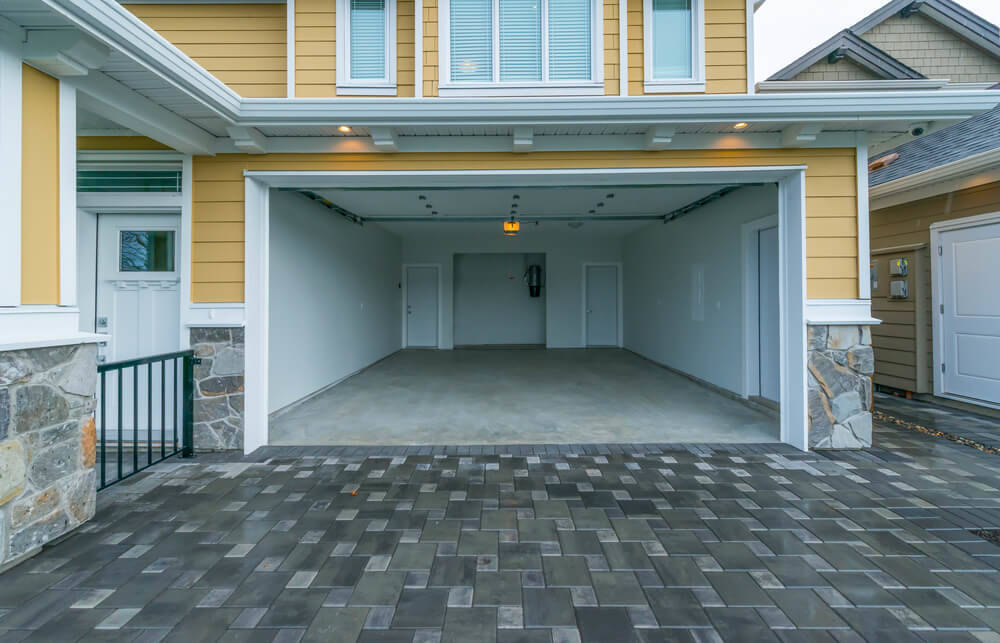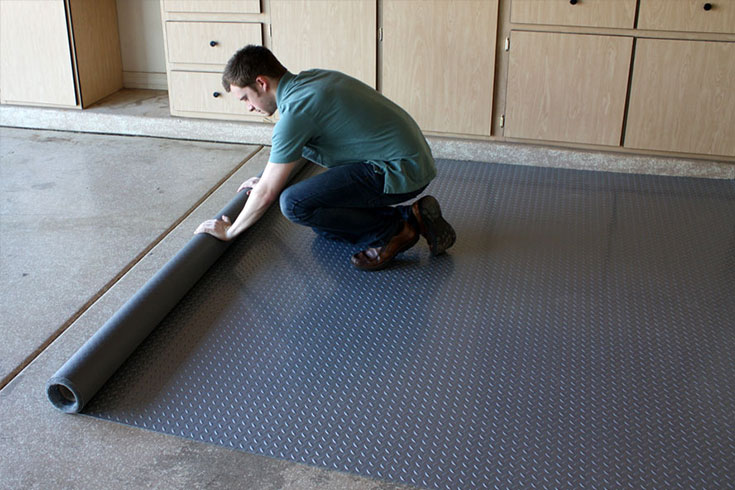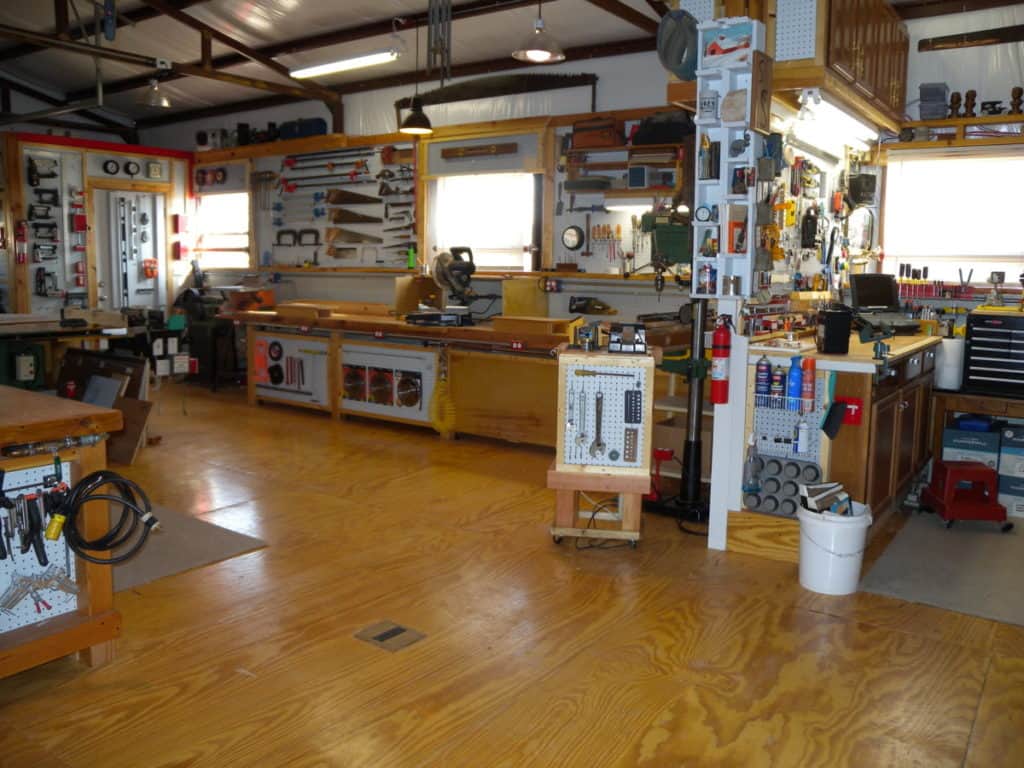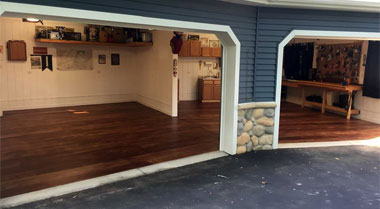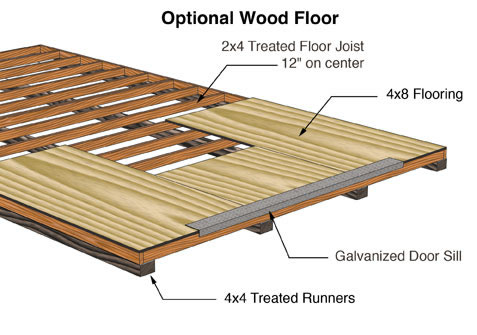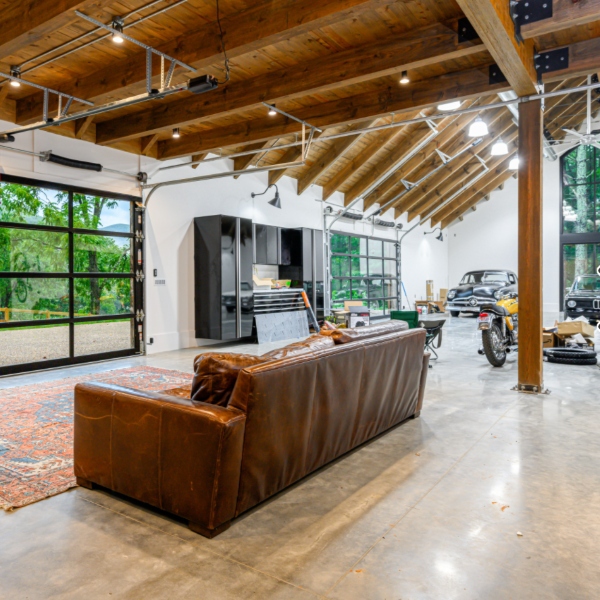Benefits of Installing Wood Floors in Garages
Wood flooring may not be the first material that comes to mind when thinking about garage floors, but it’s becoming an increasingly popular option for homeowners. As someone who has explored various flooring options, I can confidently say that wood brings both practicality and aesthetic appeal to your garage. Below are the key benefits of opting for wood floors in your garage. From improving the overall look of the space to providing functional advantages, wood flooring has a lot to offer.
- Enhanced Aesthetic Appeal
One of the most noticeable benefits of installing wood floors in your garage is the visual transformation. Wood has a natural warmth and character that concrete or tile simply can’t match. Whether you’re converting your garage into a workshop, a man cave, or a general storage area, wood floors create an inviting and refined atmosphere. It also allows for better design cohesion if you want your garage to blend with the rest of your home’s style. - Increased Home Value
Another significant advantage is the potential boost to your home’s resale value. A well-maintained wood floor in the garage adds a level of luxury that prospective buyers often find appealing. A garage with wood flooring can be marketed as a flexible, multipurpose space, which can justify a higher asking price when it’s time to sell your home. - Insulation Benefits
Wood is a naturally insulating material, which means it will help keep your garage warmer in the winter and cooler in the summer. This is especially useful if your garage doubles as a workshop or living space. Unlike concrete, which can become cold and uncomfortable, wood helps regulate the temperature, making the space more comfortable to use year-round. - Comfort Underfoot
If you spend a lot of time in your garage working on projects, wood flooring is much more forgiving on your feet and joints than harder materials like concrete or tile. The natural give of wood offers a cushioned feel, which is great for those long hours spent standing or moving around. - Durability When Properly Maintained
Contrary to popular belief, wood floors can be highly durable when installed and maintained properly, even in a garage. With the right finish and sealants, wood floors can resist wear and tear from heavy machinery, tools, and vehicles. More on that later, but it’s important to note that durability isn’t sacrificed when you choose wood over other materials. - Customizable and Versatile
Finally, wood floors offer a high level of customization. Whether you prefer a modern, rustic, or classic look, there are a variety of wood types, stains, and finishes to choose from. This allows you to design the garage floor that perfectly matches your vision.

Types of Wood Suitable for Garage Flooring
When it comes to choosing wood for your garage floor, not all species are created equal. Some types of wood are more durable and better suited to the unique conditions found in a garage. Let me walk you through the different types of wood that work best in a garage environment. The key factors to consider are durability, resistance to moisture, and ease of maintenance.
Engineered Hardwood
One of the most recommended types of garage flooring is engineered hardwood. It’s made by bonding a thin layer of hardwood to a plywood base, giving it more stability and resistance to moisture compared to solid hardwood. Engineered hardwood holds up well to temperature fluctuations and humidity changes, which are common in garages. It’s also less prone to warping, making it an excellent choice if you’re worried about long-term durability.
Oak
Oak is a classic option for wood flooring in general, and it can also be a strong contender for garage floors. Oak is known for its durability and toughness, which is exactly what you need in a space that will see a lot of traffic and the occasional spill. Red and white oak are both popular options, but white oak tends to be slightly more resistant to moisture, making it the better choice for a garage setting.
Bamboo
If you’re looking for an eco-friendly option, bamboo is a great choice. Bamboo is technically a grass, but it’s harder than many hardwoods, making it extremely durable. It’s also resistant to moisture and stains, which is a major plus in a garage environment. Bamboo offers a sleek, modern look while being tough enough to handle the wear and tear of daily use.
Reclaimed Wood
For those who want a unique, rustic look, reclaimed wood can be an excellent option. Reclaimed wood is repurposed from old barns, factories, and other structures, giving it a lot of character and history. While it may require a bit more maintenance to ensure it’s properly sealed and protected, the charm and sustainability factor make reclaimed wood a worthwhile consideration for your garage floor.
Maple
Maple is another solid choice, particularly for garages that double as workshops. It’s one of the hardest domestic hardwoods, which makes it great for withstanding heavy impacts, dents, and scratches. Maple also has a smooth, uniform grain that gives it a clean, contemporary appearance, perfect for a polished, modern garage.
Cedar
Cedar isn’t as hard as some of the other woods listed, but it’s highly resistant to moisture and decay, which makes it an ideal option for garages that may be exposed to damp conditions. Its natural resistance to pests and rot can give it a longer lifespan with minimal maintenance. Plus, cedar has a beautiful grain and a distinct, pleasant aroma that adds to its appeal.
How to Prepare Your Garage for Wood Flooring Installation
Preparing your garage for wood flooring installation is an essential step that ensures the longevity and functionality of your new floor. Skipping this step can lead to issues down the road, so it’s worth taking the time to do it right. I’ll walk you through the process of preparing your garage for a successful wood floor installation.
Clear and Clean the Space
First things first, you need to empty the garage. Remove all cars, tools, and storage items to give yourself a clean slate. Once the space is cleared, thoroughly sweep and mop the floor to remove dirt, debris, and oil stains. Any residual grime can affect the installation process and reduce the lifespan of your wood floor. You may also need to degrease the surface if there are any oil spills.
Check for Moisture
One of the biggest concerns with installing wood flooring in a garage is moisture. Concrete floors can absorb moisture from the ground, which can warp or damage wood over time. Before installing your wood floor, you’ll need to test for moisture levels using a moisture meter. If the readings are too high, you may need to install a vapor barrier or dehumidify the space before proceeding.
Level the Subfloor
It’s essential that the garage floor is level before you install wood flooring. Use a level to check for any dips or slopes in the concrete. If the floor is uneven, you may need to apply a leveling compound to smooth it out. A level floor will not only ensure a successful installation but will also prevent future issues like uneven wear or gaps between the wood planks.
Install a Subfloor
In most cases, you’ll want to install a subfloor over the concrete to provide a stable base for the wood flooring. Plywood is a popular option for subflooring in garages because it’s durable and cost-effective. The subfloor acts as a buffer between the concrete and the wood, protecting the wood from any moisture and providing added insulation.
Apply a Vapor Barrier
Even if your garage doesn’t have a moisture problem, it’s a good idea to install a vapor barrier between the concrete and the subfloor. This can be in the form of a plastic sheet or specialized vapor barrier products. The barrier helps prevent any moisture from seeping into the wood over time, which is especially important if you live in a humid climate or if your garage has a history of water seepage.
Acclimate the Wood
Before installing the wood flooring, it’s important to let the wood acclimate to the garage environment. This means leaving the wood planks in the garage for at least 48 hours to adjust to the temperature and humidity levels. Acclimating the wood helps prevent expansion or contraction after installation, ensuring a snug fit and a longer-lasting floor.
Wood Floor Finishes for Durability in Garages
Choosing the right finish for your wood garage floor is crucial to making sure it stands up to the rigors of daily use. In a space like a garage, where spills, dirt, and heavy items are common, a durable finish can make all the difference. Let’s explore the best wood floor finishes that will protect your garage floor from wear and tear while enhancing its appearance.
Polyurethane Finish
Polyurethane is one of the most popular finishes for wood flooring, and for good reason. It provides a tough, protective layer that resists scratches, moisture, and chemicals. For garages, opt for an oil-based polyurethane, as it’s thicker and more durable than its water-based counterpart. It also gives the wood a rich, warm glow that enhances its natural beauty. Once applied, polyurethane can last for years with minimal maintenance.
Epoxy Coating
While epoxy is typically associated with concrete floors, it can also be applied over wood to create a highly durable surface. Epoxy is resistant to chemicals, stains, and heavy impacts, making it an excellent choice for a garage that sees a lot of use. It’s also available in a range of colors, so you can customize the look of your wood floor while giving it an industrial-level layer of protection.
Penetrating Oil Finishes
For those who prefer a more natural look, penetrating oil finishes like tung oil or linseed oil are great options. These oils soak into the wood, providing a subtle, matte finish that enhances the wood’s grain. While they don’t offer as much protection as polyurethane or epoxy, they do make the wood easier to repair. You can reapply oil to worn areas without needing to sand down the entire floor.
Hard Wax Oil
Hard wax oil finishes combine the best of both worlds, offering the durability of a synthetic finish with the natural look of penetrating oil. It forms a hard, protective surface that can withstand moderate wear and tear, while still allowing the wood to breathe. Hard wax oil is also easy to maintain and touch up, making it a practical choice for garage floors that see regular use.
Water-Based Sealers
If you’re looking for a low-VOC, environmentally-friendly option, water-based sealers are a great alternative. They dry quickly, have minimal odor, and are easier to clean up compared to oil-based finishes. While they may not be as durable as some other options, water-based sealers still offer decent protection against moisture and light wear, making them suitable for garages that are used less intensively.
Stain and Seal Combo
If you want to add some color to your wood floor while protecting it at the same time, consider using a stain-and-seal combination. This type of product allows you to apply color and finish in one step, which can save you time during the installation process. A high-quality stain-and-seal combo can provide both aesthetic appeal and long-lasting durability for your garage floor.
Maintaining and Cleaning Wood Garage Floors
Wood garage floors, while beautiful and durable, require regular maintenance to keep them looking their best. The good news is that with the right approach, cleaning and maintaining your wood floor can be simple and effective. I’ll cover the best practices for keeping your wood garage floor in top condition.
Regular Sweeping and Vacuuming
One of the simplest ways to maintain your wood garage floor is by regularly sweeping or vacuuming it. Dirt, dust, and debris can act like sandpaper, scratching the surface of the wood over time. I recommend sweeping the floor at least once a week, or more often if you use the garage frequently. A soft-bristle broom or a vacuum designed for hard floors will help you keep the surface clean without causing any damage.
Wipe Up Spills Immediately
Spills are inevitable in a garage, but they can be particularly damaging to wood floors if left unattended. Whether it’s oil, gasoline, or water, any liquid that sits on the wood can seep in and cause stains or warping. As soon as a spill occurs, wipe it up with a clean cloth or paper towel to prevent damage. For tougher spills like oil, a mild degreaser can help lift the stain without harming the wood.
Use Rugs and Mats in High-Traffic Areas
To protect your wood floor from excessive wear, consider placing rugs or mats in high-traffic areas, such as the entrance or near workbenches. These mats will help catch dirt, debris, and moisture before they come into contact with the wood. Just make sure to choose rugs that are breathable and won’t trap moisture underneath, as this can cause mold or mildew to develop.
Apply a Protective Coating Periodically
Even the most durable finishes will wear down over time, especially in a garage where the floor is exposed to heavy use. To extend the life of your wood floor, it’s a good idea to reapply a protective coating every few years. Depending on the type of finish you’ve used—whether polyurethane, oil, or wax—you may need to sand the surface lightly before applying a fresh coat.
Avoid Harsh Cleaners
When it comes to cleaning wood floors, avoid using harsh chemicals or abrasive cleaners. These can strip the finish and damage the wood underneath. Instead, opt for a cleaner specifically designed for wood floors, or use a solution of water and a mild soap. Be sure to wring out your mop or cloth thoroughly, as too much water can cause the wood to swell and warp.
Inspect for Damage Regularly
Finally, it’s important to inspect your wood garage floor regularly for any signs of damage, such as scratches, dents, or water damage. Catching these issues early will make it easier to repair them before they become bigger problems. If you notice any significant damage, you may need to sand and refinish the affected area, or in severe cases, replace individual planks.
Cost Considerations for Wood Garage Flooring
Wood flooring is undoubtedly an investment, but it’s important to understand the full range of costs involved before making a decision. In this section, I’ll break down the various cost factors you should consider when installing wood floors in your garage. From material costs to installation and long-term maintenance, several elements can impact your budget.
Material Costs
The cost of the wood itself will likely be your largest expense. Prices can vary significantly depending on the type of wood you choose. For example, engineered hardwood tends to be more affordable, while exotic woods like teak or mahogany can be quite pricey. On average, you can expect to pay anywhere from $3 to $12 per square foot for wood flooring materials.
Installation Costs
Unless you’re planning to install the wood flooring yourself, you’ll need to factor in labor costs. Professional installation typically ranges from $4 to $8 per square foot, depending on the complexity of the job. If your garage floor needs significant preparation—like leveling, moisture barriers, or subflooring—these costs can increase. It’s always a good idea to get multiple quotes from contractors to ensure you’re getting a fair price.
Subfloor and Vapor Barrier Costs
In many cases, a subfloor and vapor barrier are necessary to protect the wood from moisture and provide a stable surface. Subfloor materials like plywood can add $1 to $2 per square foot to your budget. A vapor barrier, which is essential for preventing moisture damage, can cost anywhere from $0.50 to $2 per square foot, depending on the type you choose.
Finish and Sealer Costs
The type of finish you apply to your wood floor will also affect your overall costs. High-quality finishes like polyurethane or epoxy can range from $2 to $4 per square foot. If you opt for a professional to apply the finish, you’ll need to account for labor costs as well. Finishing your wood floor is an essential step for durability, so it’s worth investing in a quality product.
Maintenance Costs
While wood floors are relatively easy to maintain, they do require some upkeep over time. You’ll need to factor in the cost of cleaning products, rugs or mats for high-traffic areas, and any future refinishing or repairs. Refinishing a wood floor can cost around $2 to $5 per square foot, but this will depend on the extent of the damage and the type of finish used.
Long-Term Value
It’s important to view wood flooring as a long-term investment. While the upfront costs may be higher than other materials like concrete or tile, wood floors can increase the overall value of your home. Additionally, well-maintained wood floors can last for decades, making them a cost-effective choice in the long run. Be sure to consider both the initial expenses and the long-term benefits when budgeting for your garage floor.
Alternatives to Traditional Wood Flooring for Garages
While wood flooring offers a beautiful and durable option for garages, it may not be the best fit for everyone. If you’re considering other materials, there are several great alternatives to traditional wood flooring that offer their unique advantages. Let’s explore some of these options and how they compare to wood in terms of cost, durability, and aesthetics.
Vinyl Plank Flooring
Vinyl plank flooring has gained popularity in recent years as a cost-effective and durable alternative to wood. It mimics the look of real wood but is made from synthetic materials, which makes it more resistant to moisture and temperature fluctuations. Vinyl planks are also easier to install than hardwood, often featuring a click-lock system that can be done as a DIY project. Plus, it’s much more affordable, with prices typically ranging from $2 to $5 per square foot.
Laminate Flooring
Laminate is another budget-friendly alternative that can give you the look of wood without the high price tag. Like vinyl, laminate is resistant to moisture and scratches, making it a practical choice for garages. It’s also easy to install and maintain. However, laminate doesn’t have the same natural warmth or character as real wood, and it may not add as much value to your home in the long term.
Rubber Flooring
Rubber flooring is often used in gyms and workshops, but it can also be a great option for garages. It’s durable, resistant to chemicals, and provides excellent traction, making it ideal for spaces where heavy equipment or vehicles are used. Rubber flooring is available in tiles or rolls, and installation is relatively easy. While it doesn’t mimic the look of wood, it offers superior durability and comfort underfoot.
Epoxy Coated Concrete
Epoxy coatings are a popular choice for garage floors because of their durability and resistance to chemicals, oil, and heavy impacts. Applying an epoxy coating to a concrete floor creates a seamless, glossy finish that’s easy to clean and maintain. While it lacks the warmth and aesthetic appeal of wood, epoxy is one of the most practical and long-lasting options for a garage.
Cork Flooring
For those who want an eco-friendly alternative to wood, cork flooring is worth considering. Cork is a renewable material that provides a cushioned feel underfoot, making it ideal for garages used as workshops or recreational spaces. It’s also resistant to mold, mildew, and pests. However, cork can be prone to dents and scratches, so it may not be the best choice for garages with heavy machinery or vehicles.
Interlocking Tiles
If you’re looking for a quick and easy flooring solution, interlocking tiles made from materials like rubber, PVC, or even wood composites can be a great alternative. These tiles simply snap together and can be installed over most existing floors without the need for adhesives. They’re available in a wide range of colors and patterns, allowing you to customize the look of your garage. Interlocking tiles are also easy to replace if damaged, making them a practical and affordable option.
Spruce Up Your Shop: Install a Wood Floor
Pin on Floors @ Home
Vinyltrax: Premium Vinyl Floor Tiles Transform Your Floor In
Luxury Vinyl Plank Flooring Kit 1000 sq. ft. NewAge Products
Rustic Wood Flooring Concrete Wood Flooring Contractor
Sierra 12×24 Wood Storage Garage Shed Kit – ALL Pre-Cut
Take Your Garage to the Next Level with Luxury Vinyl Garage Flooring
Related Posts:


